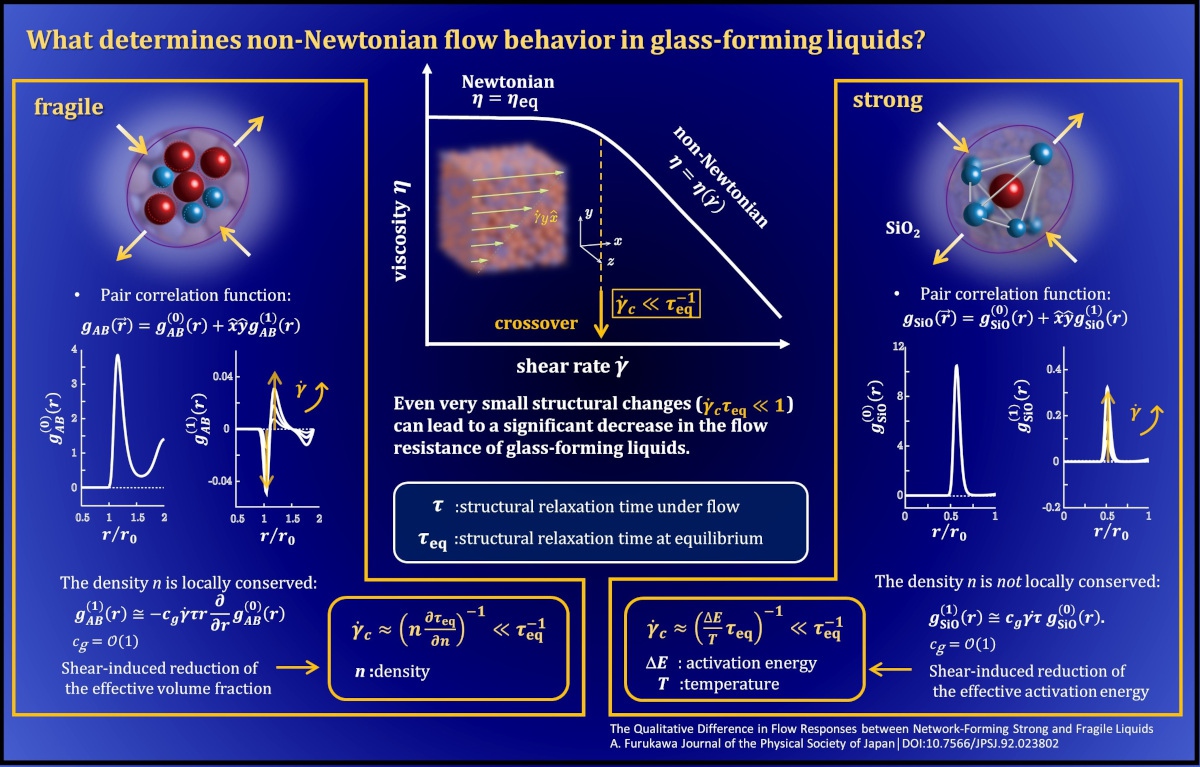What Determines Non-Newtonian Flow Behavior in Glass-Forming Liquids?
© The Physical Society of Japan
This article is on
The Qualitative Difference in Flow Responses between Network-Forming Strong and Fragile Liquids
(JPSJ Editors' Choice)
J. Phys. Soc. Jpn.
92,
023802
(2023)
.
Even minute structural changes can lead to significant reductions in the flow resistances of glass-forming liquids. Here, possible scenarios and predictions for two different classes of glass-forming liquids are provided.

Shear thinning, where viscosity decreases as imposed shear rate increases, is one of the most ubiquitous non-Newtonian flow phenomena in various soft matter systems. One such system, a glass-forming liquid, exhibits significant shear thinning, but the underlying mechanism remains unclear.
When investigating the rheological properties of molecular or particulate fluids, the Péclet number defined as Pe = [advective transport rate]/[diffusive transport rate] is used to estimate the degree of departure from an equilibrium relaxation mechanism. In glass-forming liquids, the timescale of particle diffusion is usually identified with the structural relaxation time τ . Flows with Pe ~ Ýτ >1 indicate the dominance of advective effects over equilibrium structural relaxation mechanisms. Crossovers from Newtonian to non-Newtonian flow behaviors at Pe ~ 1 are observed in many soft matter systems, including polymers, liquid crystals, and critical fluids.
Therefore, similar crossovers might be expected to occur in glass-forming liquids. However, re-examining Pe at the onset of shear thinning in most simulations and experiments of glass-forming liquids indicates that shear thinning starts even when Pe is several orders of magnitude less than one. For Pe << 1, the flow effects are weak; the structural distortion induced by the applied flow is smaller than that induced by thermal fluctuations. This rheological feature of glass-forming liquids raises a question of why such tiny flow effects significantly alter the relaxation mechanism.
Extensive simulation studies have focused on the physical mechanism of shear-thinning behaviors; these studies mainly focused on fragile glass-forming liquids. However, there is another important class called strong glass-forming liquids. These two classes have distinct density and temperature dependencies on the structural relaxation time, indicating their distinct relaxation mechanisms. Therefore, although both strong and fragile liquids show similar shear-thinning behaviors, the two classes do not necessarily share a common underlying mechanism.
This paper provides possible new shear-thinning scenarios for ‘‘strong’‘ and ‘‘fragile’‘ glass-forming liquids; quantitative relationships between shear rate and viscosity reduction are derived and used to explain how and why viscosity can be significantly altered even at Pe<<1. The predictions agree with the molecular dynamics simulation results and readily apply to realistic problems, because they are expressed in terms of experimental observables. The shear thinning observed in glass-forming liquids often develop into more complex phenomena, like shear bands and fractures, which significantly modify the flow and mechanical properties of the system. Therefore, understanding the shear-thinning mechanism is essential for industrial applications in glassy materials production and processing, and for understanding large-scale volcanic phenomena like lava flows. This study enhances the understanding of such phenomena and advances the investigation of more complex nonlinear flow phenomena.
The Qualitative Difference in Flow Responses between Network-Forming Strong and Fragile Liquids
(JPSJ Editors' Choice)
J. Phys. Soc. Jpn.
92,
023802
(2023)
.
Share this topic
Fields
Related Articles
-
Exploring the Vibrant Interplay of Machine Learning and Physics
Cross-disciplinary physics and related areas of science and technology
Electron states in condensed matter
Elementary particles, fields, and strings
Mathematical methods, classical and quantum physics, relativity, gravitation, numerical simulation, computational modeling
Statistical physics and thermodynamics
Superconductivity
2025-3-13
This Journal of the Physical Society of Japan Special Topics edition explores how physics and machine learning complement each other and can solve unresolved problems in physics.
-
Bayesian Insights into X-ray Laue Oscillations: Quantitative Surface Roughness and Noise Modeling
Measurement, instrumentation, and techniques
Structure and mechanical and thermal properties in condensed matter
2025-2-14
This study adopts Bayesian inference using the replica exchange Monte Carlo method to accurately estimate thin-film properties from X-ray Laue oscillation data, enabling quantitative analysis and appropriate noise modeling.
-
Hyperuniform and Multifractal States in Bosonic Quasicrystalline Systems
Statistical physics and thermodynamics
Structure and mechanical and thermal properties in condensed matter
2025-2-10
Quantum states can be categorized as hyperuniform or multifractal based on electronic characteristics. This study demonstrates that bosonic quasicrystalline systems exhibit hyperuniform or multifractal quantum states.
-
Exploring Materials without Data Exposure: A Bayesian Optimizer using Secure Computation
Cross-disciplinary physics and related areas of science and technology
Measurement, instrumentation, and techniques
2025-2-6
Secure computation allows the manipulation of material data without exposing them, thereby offering an alternative to traditional open/closed data management. We recently reported the development of an application that performs Bayesian optimization using secure computation.
-
Triangular Lattice Magnet GdGa2: Spin Cycloids and Skyrmions
Cross-disciplinary physics and related areas of science and technology
Electronic transport in condensed matter
Magnetic properties in condensed matter
2025-2-3
Careful measurements were conducted on the hexagonal magnet GdGa2 to reveal the experimental signatures of ultrasmall spin cycloids and of a potential Néel-type skyrmion lattice phase induced by a magnetic field.




